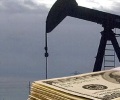

Oil prices have risen above the long-term average, once adjusted for inflation, and are likely to encounter increasing resistance from consumers if they continue to climb.
Front-month Brent futures are trading around US$75 per barrel compared with an inflation-adjusted median of just over US$70 since the start of the century.
Hedge funds and other money managers are confident prices will rise further, with bullish long positions outnumbering bearish short ones in crude by a ratio of 6:1.
Investment bank Goldman Sachs has forecast prices will hit US$80 this summer as the deployment of coronavirus vaccines allows more businesses to open and travel to resume.
Nevertheless, the Organization of the Petroleum Exporting Countries and its allies (OPEC+) as well as US shale producers are increasing output cautiously.
Scott Sheffield, chief executive of Pioneer Natural Resources, one of the largest shale producers, has said “I’m still confident the producers will not respond” to the run-up in prices. A focus on shareholder returns has kept spending low, he said in an interview with Reuters.
“Oil prices will probably break US$80 a barrel here shortly and I don’t see any rig adds,” Sheffield said.
But if prices continue rising to US$80 and more, the increase is likely to draw more responses from policymakers, businesses and motorists in the major consuming countries.
In real terms, Brent has been below US$80-88 per barrel for 60-67 per cent of the time since 2000, so consumers are likely to perceive prices above this level as high in comparison with recent experience.
Somewhere between US$75 and US$85, oil prices will start to become politically sensitive and have an impact on consumer behaviour and petroleum use.
In particular, high prices will encourage an intensified focus on reducing consumption of petroleum-based fuels and accelerating the switch to alternatives such as electric vehicles.
PRICE RESPONSE
In 2005, when prices climbed above US$80 in real terms, the US Congress mandated a big increase in the volume of ethanol blended into the fuel supply to cut expensive petroleum consumption in the Energy Policy Act.
In 2007, with real prices again above US$80, Congress toughened vehicle fuel economy standards to lower petroleum consumption in the Energy Independence and Security Act.
Over the last two decades, whenever prices have been much above US$80, U.S. businesses and motorists have opted for smaller, lighter and more fuel-efficient vehicles to reduce operating costs.
In the United States and Europe, with hybrid and full-electric vehicles widely available for the first time, a sharp increase in the cost of oil is likely to accelerate their adoption and reduce petroleum consumption.
High prices are also likely to draw adverse attention from legislators and regulators, especially in the United States, about competition in the oil market.
Real prices above US$80 have been associated with increased interest from US legislators in stripping sovereign antitrust immunity from OPEC.
During the Trump administration, the White House pressed OPEC for more output whenever nominal prices climbed above US$75.
The Biden administration is unlikely to conduct oil diplomacy publicly via Twitter, but it will be sensitive to the impact of high and rising prices on swing voters, and may exert quiet informal pressure.
“While oil prices are shaped by global forces, the President knows that gas prices are a pain point for Americans – especially the middle-class families he’s put at the centre of his economic agenda,” the White House said in a statement at the end of May after gasoline prices rose following the Colonial pipeline disruption.
LOST CONSUMPTION
Policy and consumer responses to oil prices are non-linear. The higher prices rise and the longer they are expected to remain high, the bigger the response from policymakers and users.
Policy and consumer responses are likely to be limited at US$75 but noticeable if Brent reaches US$85 and very significant at US$95.
In most cases, once consumption has been lost during a period of high prices, it has not recovered, except as a result of an extended period of prices well below the long-term average.
Policy and consumer responses generally have a significant impact on oil demand and consumption with a delay of at least 12-36 months (in some cases much longer).
Because of the delays involved, the threat of increased conservation and switching to non-petroleum substitutes will not necessarily prevent prices from rising above US$80 or even higher in the next 12-24 months.
But it will likely accelerate the transition to alternatives in the medium and longer term, as consumers seek to lower fuel bills and increase their energy security.
By the time the impact on consumption is evident in the published statistics, it will be difficult to reverse, and help create conditions for the next slump in oil prices.
Climate campaigners and promoters of electric vehicles may welcome a temporary price spike, since it would strengthen their case for an accelerated transition to zero-emission vehicles.
For OPEC+, US shale producers and the rest of the oil industry, however, significantly higher prices in the short term are likely to lead to an accelerated loss of demand by the second half of the decade.
In thinking about their strategy, oil producers must weigh up short-term revenue gains from a spike in prices against long-term revenue losses from an accelerated reduction in oil consumption.
Source: Reuters